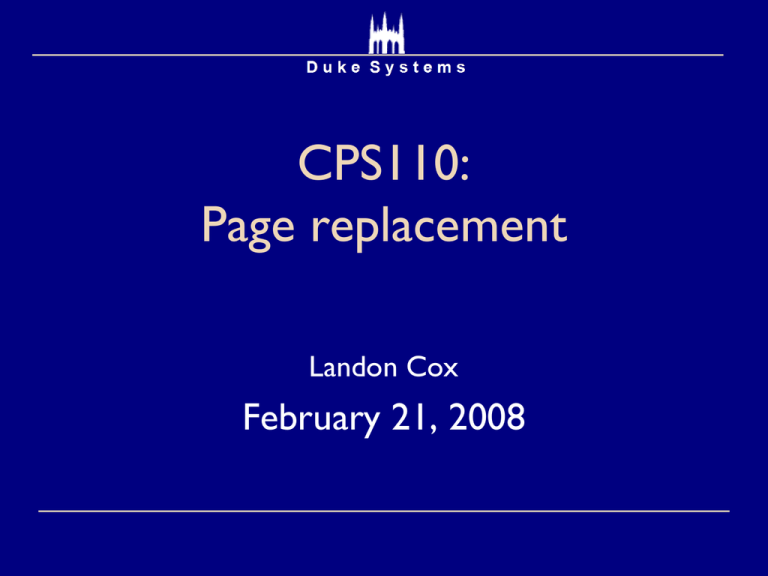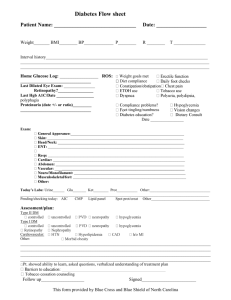CPS110: Page replacement February 21, 2008 Landon Cox
advertisement

CPS110:
Page replacement
Landon Cox
February 21, 2008
Dynamic address translation
User process
Virtual
address
Translator
(MMU)
Physical
address
Translator: just a data structure
Tradeoffs
Flexibility (sharing, growth, virtual memory)
Size of translation data
Speed of translation
Physical
memory
2. Segmentation
Segment #
Base
Bound
Segment 0
4000
700
Code
Segment 1
0
500
Data segment
Segment 2
Unused
Unused
Segment 3
2000
1000
Segment #
Stack segment
Virtual memory
Physical memory
(3,fff)
.
(3,000)
…
(1,4ff)
.
(1,000)
…
(0,6ff)
.
(0,0)
46ff
.
4000
…
2fff
.
2000
…
4ff
.
0
(Stack)
Offset
(Data)
(Code)
(Code segment)
(Stack segment)
(Data segment)
Virtual addresses
VA={b31,b30,…,b12,b11,…,b1,b0}
High-order bits
Low-order bits
(segment number)
(offset)
3. Paging
Very similar to segmentation
Allocate memory in fixed-size chunks
Chunks are called pages
Virtual addresses
Virtual page # (e.g. upper 20 bits)
Offset within the page (e.g. low 12 bits)
3. Paging
Translation data is a page table
Virtual page #
Physical page #
0
10
1
15
2
20
3
invalid
…
…
1048574
Invalid
1048575
invalid
3. Paging
Translation process
if (virtual page # is invalid) {
trap to kernel
} else {
physical page = pagetable[virtual page].physPageNum
physical address is {physical page}{offset}
}
Page size trade-offs
If page size is too small
Lots of page table entries
Big page table
If we use 4-byte pages with 4-byte PTEs
Num PTEs = 2^30 = 1 billion
1 billion PTE * 4 bytes/PTE = 4 GB
Would take up entire address space!
Page size trade-offs
What if we use really big (1GB) pages?
Internal fragmentation
Wasted space within the page
Recall external fragmentation
(wasted space between pages/segments)
Page size trade-offs
Compromise between the two
x86 page size = 4kb for 32-bit processor
Sparc page size = 8kb
For 4KB pages, how big is the page table?
1 million page table entries
32-bits (4 bytes) per page table entry
4 MB per page table
Paging pros and cons
+ Simple memory allocation
+ Can share lots of small pieces
(how would two processes share a page?)
(how would two processes share an address space?)
+ Easy to grow address space
– Large page tables (even with large invalid section)
Comparing translation schemes
Base and bounds
Unit of translation = entire address space
Segmentation
Unit of translation = segment
A few large variable-size segments/address space
Paging
Unit of translation = page
Lots of small fixed-size pages/address space
What we want
Efficient use of physical memory
Little external or internal fragmentation
Easy sharing between processes
Space-efficient data structure
How we’ll do this
Modify paging scheme
Course administration
Latest thread library score
Thread library scores
70
60
50
40
30
20
10
0
1
2
3
4
5
6
7
8
Group number
9
1t: median = 41 (out of 64)
Total: median = 74% (last semester median = 98%)
10
11
12
Course administration
Latest thread library score
Thread library scores
70
60
50
40
30
20
10
0
2/10
2/12
2/13
2/14
2/14 2/15 2/16 2/17
Initial submit date
2/17
2/18
1t: median = 41 (out of 64)
Total: median = 74% (last semester median = 98%)
2/18
2/19
Course administration
Next week
I will be out of town
Mid-term exam on Tuesday
Amre will proctor exam
No discussion sections
Thursday lecture cancelled
Project 2 out on Thursday
Any questions about exam?
Course administration
Project 2
Posted on the web next Thursday (February 28th)
Write a virtual memory manager
Manage address spaces and page faults
Due 4 weeks from today (March 20th)
Comparison to Project 1
Less difficult concepts (no synchronization)
Lots of bookkeeping and corner cases
No solution to compare to (e.g. thread.o)
4. Multi-level translation
Standard page table
Just a flat array of page table entries
VA={b31,b30,…,b12,b11,…,b1,b0}
High-order bits
(Page number)
Low-order bits
(offset)
Used to index into table
4. Multi-level translation
Multi-level page table
Use a tree instead of an array
VA={b31,b30,…,b22,b21,…, b12,b11,…,b1,b0}
Level 1
Level 2
Low-order bits
(offset)
Used to index into table 2
Used to index into table 1
What is stored in the level 1 page table? If valid? If invalid?
4. Multi-level translation
Multi-level page table
Use a tree instead of an array
VA={b31,b30,…,b22,b21,…, b12,b11,…,b1,b0}
Level 1
Level 2
Low-order bits
(offset)
Used to index into table 2
Used to index into table 1
What is stored in the level 2 page table? If valid? If invalid?
Two-level tree
Level 1
Level 2
0
1
…
NULL
NULL
1023
?
0: PhysPage, Res, Prot
0: PhysPage, Res, Prot
1: PhysPage, Res, Prot
1: PhysPage, Res, Prot
…
…
?
?
1023: PhysPage, Res, Prot
1023: PhysPage, Res, Prot
VA={b31,b30,…,b22,b21,…, b12,b11,…,b1,b0}
Level 1
Level 2
Offset
Two-level tree
Level 1
Level 2
0
1
…
NULL
NULL
1023
0: PhysPage, Res, Prot
0: PhysPage, Res, Prot
1: PhysPage, Res, Prot
1: PhysPage, Res, Prot
…
1023: PhysPage, Res, Prot
…
1023: PhysPage, Res, Prot
How does this save space?
Two-level tree
Level 1
Level 2
0
1
…
NULL
NULL
1023
0: PhysPage, Res, Prot
0: PhysPage, Res, Prot
1: PhysPage, Res, Prot
1: PhysPage, Res, Prot
…
1023: PhysPage, Res, Prot
…
1023: PhysPage, Res, Prot
What changes on a context switch?
Multi-level translation pros and cons
+ Space-efficient for sparse address spaces
+ Easy memory allocation
+ Easy sharing
– What is the downside?
Two extra lookups per reference
(read level 1 PT, then read level 2 PT)
(memory accesses just got really slow)
Translation look-aside buffer
Aka the “TLB”
Hardware cache from CPS 104
Maps virtual page #s to physical page #s
On cache hit, get PTE very quickly
On miss use page table, store mapping, restart instruction
What happens on a context switch?
Have to flush the TLB
Takes time to rewarm the cache
As in life, context switches may be expensive
Replacement
Think of physical memory as a cache
What happens on a cache miss?
Page fault
Must decide what to evict
Goal: reduce number of misses
Review of replacement algorithms
1. Random
Easy implementation, not great results
2. FIFO (first in, first out)
Replace page that came in longest ago
Popular pages often come in early
Problem: doesn’t consider last time used
3. OPT (optimal)
Replace the page that won’t be needed for longest time
Problem: requires knowledge of the future
Review of replacement algorithms
LRU (least-recently used)
Use past references to predict future
Exploit “temporal locality”
Problem: expensive to implement exactly
Why?
Either have to keep sorted list
Or maintain time stamps + scan on eviction
Update info on every access (ugh)
LRU
LRU is just an approximation of OPT
Could try approximating LRU instead
Don’t have to replace oldest page
Just replace an old page
Clock
Approximates LRU
What can the hardware give us?
“Reference bit” for each PTE
Set each time page is accessed
Why is this done in hardware?
May be slow to do in software
Clock
Approximates LRU
What can the hardware give us?
“Reference bit” for each PTE
Set each time page is accessed
What do “old” pages look like to OS?
Clear all bits
Check later to which are set
Clock
Time 0: clear reference bit for page
.
.
.
Time t: examine reference bit
Splits pages into two classes
Those that have been touched lately
Those that haven’t been touched lately
Clearing all bits simultaneously is slow
Try to spread work out over time
Clock
A
PP
VP
Physical page 0
Physical page 1
Physical page 2
E
B
PP
VP
Physical page 3
PP
VP
Physical page 4
D
PP
VP
PP
VP
= Resident virtual pages
PP
VP
C
Clock
A
PP
VP
Physical page 0
E
Physical page 1
Physical page 2
B
PP
VP
Physical page 3
PP
VP
PP
VP
Physical page 4
D
When you need to evict a page:
1) Check physical page pointed to by clock hand
PP
VP
C
Clock
A
PP
VP
Physical page 0
E
Physical page 1
Physical page 2
B
PP
VP
Physical page 3
PP
VP
PP
VP
Physical page 4
D
PP
VP
C
When you need to evict a page:
2) If reference=0, page hasn’t been touched in a while. Evict.
Clock
A
PP
VP
Physical page 0
E
Physical page 1
Physical page 2
B
PP
VP
Physical page 3
PP
VP
PP
VP
Physical page 4
D
PP
VP
C
When you need to evict a page:
3) If reference=1, page has been accessed since last sweep.
What to do?
Clock
A
PP
VP
Physical page 0
E
Physical page 1
Physical page 2
B
PP
VP
Physical page 3
PP
VP
PP
VP
Physical page 4
D
PP
VP
C
When you need to evict a page:
3) If reference=1, page has been accessed since last sweep.
Set reference=0. Rotate clock hand. Try next page.
Clock
Does this cause an infinite loop?
No.
First sweep sets all to 0, evict on next sweep
What about new pages?
Put behind clock hand
Set reference bit to 1
Maximizes chance for page to stay in memory
Paging out
What can we do with evicted pages?
Write to disk
When don’t you need to write to disk?
Disk already has data (page is clean)
Can recompute page content (zero page)
Paging out
Why set the dirty bit in hardware?
If set on every store, too slow for software
Why not write to disk on each store?
Too slow
Better to defer work
You might not have to do it! (except in 110)
Paging out
When does work of writing to disk go away?
If you store to the page again
If the owning process exits before eviction
Project 2: other work you can defer
Initializing a page with zeroes
Taking faults
Paging out
Faulted-in page must wait for disk write
Can we avoid this work too?
Evict clean (non-dirty) pages first
Write out pages during idle periods
Project 2: don’t do either of these!
Hardware page table info
What should go in a PTE?
Protection
Physical page # Resident
(read/write)
Set by OS to control
translation. Checked by
MMU on each access.
Set by OS.
Checked by
MMU on
each access.
Set by OS to
control access.
Checked by MMU
on each access.
Dirty
Reference
Set by MMU
Set by
when page is
MMU
used. Used by
when
OS to see if
page is
modified. page has been
referenced.
Used by
OS to see
if page is
decisions?
modified.
What bits does a MMU need to make access
MMU needs to know if resident, readable, or writable.
Do we really need a resident bit? No, if non-resident, set R=W=0.
MMU algorithm
if (VP # is invalid || non-resident || protected)
{
trap to OS fault handler
}
else
{
physical page = pageTable[virtual page].physPageNum
physical address = {physical page}{offset}
pageTable[virtual page].referenced = 1
if (access is write)
{
pageTable[virtual page].dirty = 1
}
} Project 2: infrastructure performs MMU functions
Note: P2 page table entry definition has no dirty/reference bits
Hardware page table entries
Do PTEs need to store disk block nums?
No
Only the OS needs this (the MMU doesn’t)
What per page info does OS maintain?
Which virtual pages are valid
On-disk locations of virtual pages
Hardware page table entries
Do we really need a dirty bit?
Claim: OS can emulate at a reasonable overhead.
How can OS emulate the dirty bit?
Keep the page read-only
MMU will fault on a store
OS/you now know that the page is dirty
Do we need to fault on every store?
No. After first store, set page writable
When do we make it read-only again?
When it’s clean (e.g. written to disk and paged in)
Hardware page table entries
Do we really need a reference bit?
Claim: OS can emulate at a reasonable overhead.
How can OS emulate the reference bit?
Keep the page unreadable
MMU will fault on a load/store
OS/you now knows that the page has been referenced
Do we need to fault on every load/store?
No. After first load/store, set page readable
Application’s perspective
VM system manages page permissions
Application is totally unaware of faults, etc
Most OSes allow apps to request page protections
E.g. make their code pages read-only
Project 2
App has no control over page protections
App assumes all pages are read/writable


